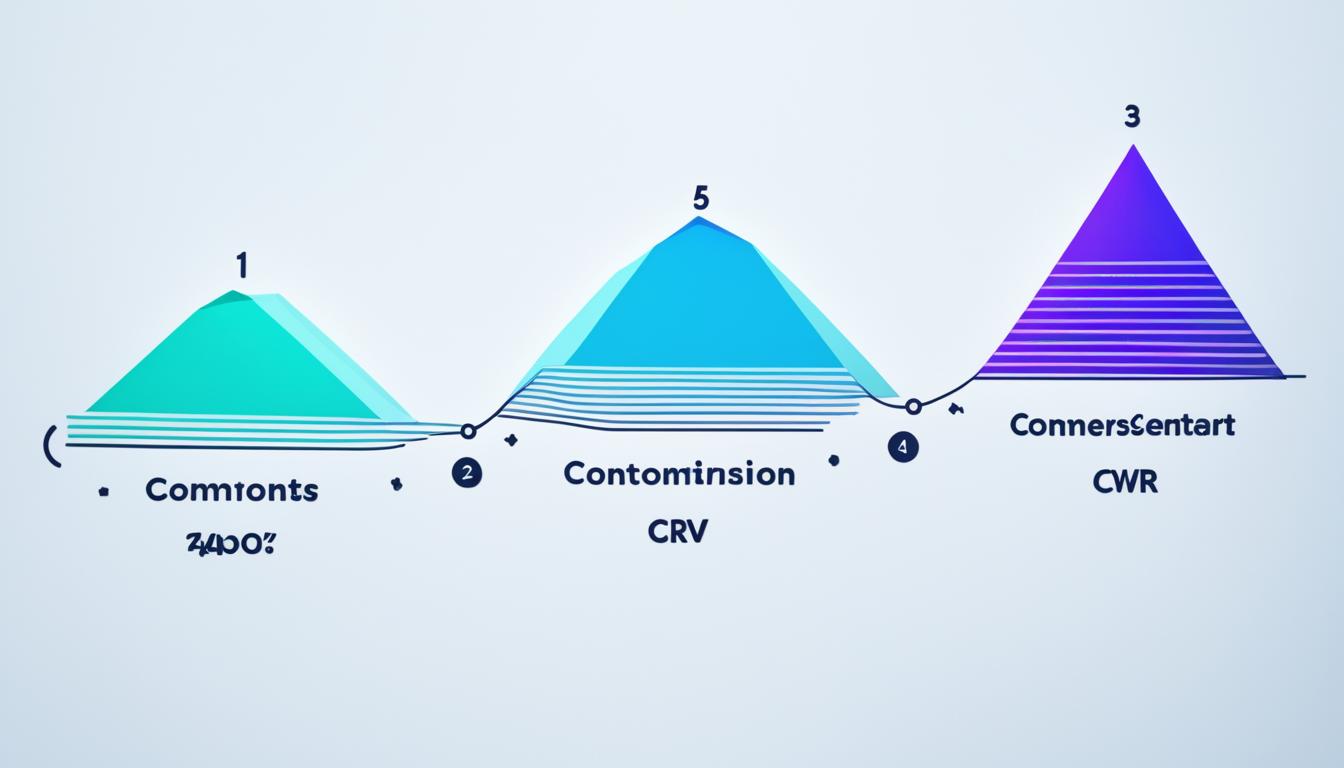A key metric in marketing is customer lifetime value (LTV). It predicts the net profit a company might get from its relationship with a customer. By looking at the average spend and how often users stop using the product, marketers can guess the future value of users. This helps them decide how to run marketing efforts and find new customers.
Key Takeaways:
- LTV, or customer lifetime value, is a metric that predicts the net profit from customer-product relationships.
- It helps in setting marketing budgets and making data-driven decisions for user acquisition and advertising spending.
- LTV is calculated by finding the average spend and churn rate of users over a specific period.
- Understanding LTV allows businesses to focus on acquiring valuable users and improving customer retention.
- By incorporating LTV into marketing strategies, companies can unlock the secrets to maximizing profitability.
What is LTV and How is it Calculated?
LTV stands for customer lifetime value. It estimates the money a customer will bring over their time with a company.
The process to find LTV involves understanding average revenue per user (ARPU) and churn rate. You can figure out LTV with this formula: LTV = ARPU x 1/Churn.
This method helps people in marketing predict how valuable customers will be. That way, they know how much to spend on getting and keeping users.
Knowing LTV lets companies recognize each customer’s worth. This helps them create marketing plans to increase the value customers bring.
The Importance of LTV in Marketing
LTV, or customer lifetime value, is crucial in marketing. It helps businesses focus on long-term profits and making the most of their customer relationships.
Maximizing LTV
To increase LTV, companies need to focus on keeping their customers. This means building stronger relationships to keep them coming back.
LTV Strategies
Effective LTV strategies involve personalized marketing. This makes customers feel special and keeps them satisfied. Happy customers stay loyal and add more value over time.
Increasing Customer Lifetime Value
Businesses can raise LTV by using data and insights. This helps improve how they get and keep customers. It also guides them in selling more to existing customers.
Efficient Resource Allocation
Knowing LTV well helps marketers spend resources wisely. It lets them focus on the most valuable customers to maximize profits.
Optimizing Marketing Campaigns
LTV gives insights into how marketing campaigns perform. Marketers can use this knowledge to target high-LTV customers. This helps improve campaign results and increase sales.
Examples of Successful LTV Strategies
Amazon Prime is a great example of a successful LTV strategy. It’s a subscription that makes customers more loyal and increases their purchases. This boosts LTV and keeps them coming back.
Insert Image here:
| Brand | LTV Strategy |
|---|---|
| Starbucks | Rewards program and personalized offers |
| Apple | Continual product innovation and brand loyalty |
| Zappos | Exceptional customer service and hassle-free returns |
| Sephora | Beauty Insider program and personalized product recommendations |
These companies have shown that focusing on LTV brings big benefits. They’ve found ways to make customers more valuable, which leads to better growth.
In conclusion, LTV is vital for successful marketing. By focusing on increasing LTV, using resources well, and improving campaigns, companies can make the most of customer relationships. This leads to greater success over time.
Challenges in Calculating LTV
Calculating LTV, or customer lifetime value, is key for marketers. But, it’s not easy to do this correctly. Since LTV changes with user behavior, the usual calculation methods might be too simple, especially for mobile marketing. You might need extra methods to understand users’ actions in different situations.
Another issue is figuring out LTV for each user, especially with lots of users. Marketers often group users to get a better LTV estimate. This grouping helps in understanding customer value better. It also means marketing money can be used more wisely.
To tackle these issues, marketers should use data deep dives. Using detailed analytics and machine learning can reveal more about customer habits. This makes forecasting LTV much clearer.
Forecasting LTV in Mobile Marketing
Mobile marketing adds its own set of challenges for calculating LTV. Mobile users act differently due to small screens, less attention, and unique patterns. For mobile LTV, you must think about how often apps are used, ad interaction, and in-app buys.
To get mobile LTV right, you need to use complex methods. Machine learning can look at lots of data to find trends for better LTV predictions. By mixing data from app stats, ad networks, and tracking user behavior, marketers can understand user value completely. This helps in making smart choices about where to spend marketing money.
Personalizing Marketing Spend Based on LTV
It’s vital to adjust marketing budgets based on LTV for better profits. Without knowing the real value of different customer groups, spending resources wisely is tough. Marketers split users into groups by LTV to better plan where to spend on getting and keeping customers.
It’s not just about how much to spend, but also how you spend it. Marketing needs to be customized. This means changing the message, where you advertise, and the offers you make based on LTV. By matching marketing to customer value, marketers can get the most return on investment and use resources efficiently.
Challenges in Calculating LTV
| Challenge | Solution |
|---|---|
| Forecasting LTV accurately | Utilize advanced analytics and machine learning algorithms to capture changing user behavior and improve forecasting accuracy. |
| Applying LTV to individual users | Segment users into cohorts to establish an overall LTV and personalize marketing spend accordingly. |
To wrap up, calculating LTV comes with its own hurdles because of always changing user behavior. Marketers need advanced methods especially for mobile, to forecast LTV well and adjust their strategies. By facing these challenges and using LTV smartly, marketers can decide based on data. This leads to higher profits and growth over time.
How LTV is Used in Marketing
LTV, or customer lifetime value, is key in marketing. It helps marketers make smart, data-informed choices. Understanding LTV guides strategies to boost profits.
Revenue Forecasting
One major use of LTV in marketing is for forecasting revenue. It lets marketers predict the money a business will make in the future. This is essential for planning, budgeting, and preparing for growth.
Resource Allocation
Effective resource allocation relies on LTV analysis too. It shows the worth of different customer groups. Marketers then wisely spread out resources. This boosts marketing efficiency and profitability.
Determining the Marketing Budget
LTV is crucial when setting the marketing budget. Knowing each customer’s lifetime revenue guides how much to spend on marketing. This helps align spending with expected returns, aiding in strategic growth decisions.
Pricing Decisions and Profitability
LTV also helps in deciding prices. It ensures prices reflect the value provided to customers. Focusing on customers with high LTV can fine-tune pricing strategies. This balance helps in maximizing profits over time.
Customer Acquisition and Retention Strategies
Furthermore, LTV informs how to attract and keep customers. Focusing on customers likely to bring high LTV shapes marketing strategies. It also shapes how to keep these customers loyal. This dual approach fuels growth and profit in the long run.
| Revenue Forecasting | Resource Allocation | Determining the Marketing Budget | Pricing Decisions and Profitability | Customer Acquisition and Retention Strategies | |
|---|---|---|---|---|---|
| Key Benefits | Aids in projecting future revenue and setting goals | Enables strategic allocation of resources for maximum ROI | Helps in making informed decisions about budget allocation | Guides pricing strategies for optimal profitability | Supports targeted efforts for acquiring and retaining valuable customers |
| Impact | Ensures financial stability and growth | Optimizes marketing efforts and maximizes profitability | Aligns marketing spend with potential ROI | Improves pricing strategies and revenue generation | Drives long-term growth and customer loyalty |
Strategies to Increase LTV
Raising LTV (customer lifetime value) is vital for firms wanting more revenue from current customers. By using the right strategies, businesses can keep more customers, boost repeat purchases, and raise their customers’ lifetime value.
1. Focus on Customer Retention
Keeping customers is essential for high LTV. Make customer happiness a priority and form strong bonds. This means top-notch service, tailored talks, and bettering products using customer suggestions.
2. Optimize the Onboarding Process
The onboarding process is crucial in starting a great customer experience. A smooth, user-friendly onboarding helps ensure customers start off happy. Include clear guides, offer help resources, and quickly answer any concerns.
3. Implement Upselling and Cross-selling
Upselling and cross-selling can really boost LTV. Suggesting related products or upgrades encourages customers to spend more. Use customer data to make recommendations that suit their tastes and needs.
4. Provide Outstanding Support
Great customer support increases loyalty and retention. Solve customers’ problems fast to build trust and a stronger relationship. Offer help through various channels and train your staff to be caring and knowledgeable.
| Benefits of Increasing LTV | Strategies to Increase LTV |
|---|---|
|
|
By adopting these strategies, companies can grow their customers’ LTV and support sustainable growth. Recognizing LTV’s importance and enhancing customer retention and profit from existing clients leads to more profit and success.
LTV in Conversion Rate Optimization
Conversion rate optimization (CRO) is key in marketing. Knowing customer lifetime value (LTV) is vital. LTV helps businesses figure out which goals are most valuable. They can then focus on what really helps grow customer value.
For CRO, it’s about knowing the worth of every small and big step a customer takes. This way, businesses can see how these steps impact LTV. Knowing which steps keep customers and bring in money lets marketers focus on what matters most.
Incorporating LTV into CRO strategy lets businesses smartly use their marketing budget. Knowing the LTV of customers guides where to spend money. This helps marketers find where to invest for the best returns.
Optimizing Conversion Metrics for LTV
Focusing on the right metrics is crucial when thinking about LTV and profit. Bigger steps like purchases show the real value of a customer. Small steps are still important but the big ones really show if your efforts are paying off.
Looking at conversion metrics linked to LTV helps pinpoint what to work on. Doing this makes sure marketing is pushing towards increasing customer value. This is key for a successful strategy.
| Conversion Metrics | Value Contribution to LTV |
|---|---|
| Email Subscriptions | Medium |
| Purchase Conversions | High |
| Subscription Renewals | High |
| Upgrades | High |
| Referrals | Medium |
| Engagement Metrics (time spent, pages visited) | Low |
Using data for CRO lets businesses spend their money wisely. Choosing actions that give more to LTV makes sure money is used well. This means better profits and more value from each customer.
Conclusion
Understanding customer lifetime value (LTV) is key to marketing success. It shows us the long-term worth of customers. This helps businesses make smart decisions and create strategies that work.
Calculating LTV helps marketers spot ways to make customers more valuable. They can use their resources smarter, improve ads, and look for high-value customers. Keeping customers happy and offering great support are important too.
Using LTV in marketing plans helps increase profits. It makes businesses focus on the value customers bring over time. LTV is a crucial metric that helps with smart decisions on keeping and finding customers.
In today’s market, understanding and using LTV is vital. Knowing the importance of LTV and using it right can help businesses grow. They can stand out and keep growing in a competitive world.





